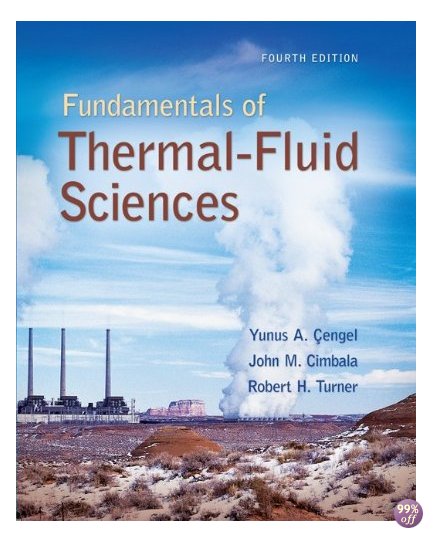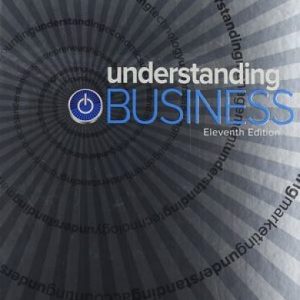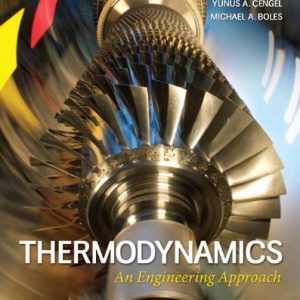This is completed downloadable of Solution Manual for Fundamentals of Thermal Fluid Sciences 4th Edition by Cengel

Product Details:
- ISBN-10 : 9352601998
- ISBN-13 : 978-9352601998
- Author: CENGEL
Please Read Notes: Brand New, International Softcover Edition, Printed in black and white pages, minor self wear on the cover or pages, Sale restriction may be printed on the book, but Book name, contents, and author are exactly same as Hardcover Edition. Fast delivery through DHL/FedEx express.
Table of Content:
- CHAPTER ONE INTRODUCTION AND OVERVIEW
- 1–1 Introduction to Thermal-Fluid Sciences
- 1–2 Thermodynamics
- 1–3 Heat Transfer
- 1–4 Fluid Mechanics
- 1–5 Importance of Dimensions and Units
- 1–6 Problem-Solving Technique
- Summary
- References and Suggested Readings
- Problems
- PART 1 THERMODYNAMICS
- CHAPTER TWO BASIC CONCEPTS OF THERMODYNAMICS
- 2–1 Systems and Control Volumes
- 2–2 Properties of a System
- 2–3 Density and Specific Gravity
- 2–4 State and Equilibrium
- 2–5 Processes and Cycles
- 2–6 Temperature and the Zeroth Law of Thermodynamics
- 2–7 Pressure
- 2–8 The Manometer
- 2–9 The Barometer and Atmospheric Pressure
- Summary
- References and Suggested Readings
- Problems
- CHAPTER THREE ENERGY, ENERGY TRANSFER, AND GENERAL ENERGY ANALYSIS
- 3–1 Introduction
- 3–2 Forms of Energy
- 3–3 Energy Transfer by Heat
- 3–4 Energy Transfer by Work
- 3–5 Mechanical Forms of Work
- 3–6 The First Law of Thermodynamics
- 3–7 Energy Conversion Efficiencies
- Summary
- References and Suggested Readings
- Problems
- CHAPTER FOUR PROPERTIES OF PURE SUBSTANCES
- 4–1 Pure Substance
- 4–2 Phases of a Pure Substance
- 4–3 Phase-Change Processes of Pure Substances
- 4–4 Property Diagrams for Phase-Change Processes
- 4–5 Property Tables
- 4–6 The Ideal-Gas Equation of State
- 4–7 Compressibility Factor—A Measure of Deviation from Ideal-Gas Behavior
- Summary
- References and Suggested Readings
- Problems
- CHAPTER FIVE ENERGY ANALYSIS OF CLOSED SYSTEMS
- 5–1 Moving Boundary Work
- 5–2 Energy Balance for Closed Systems
- 5–3 Specific Heats
- 5–4 Internal Energy, Enthalpy, and Specific Heats of Ideal Gases
- 5–5 Internal Energy, Enthalpy, and Specific Heats of Solids and Liquids
- Summary
- References and Suggested Readings
- Problems
- CHAPTER SIX MASS AND ENERGY ANALYSIS OF CONTROL VOLUMES
- 6–1 Conservation of Mass
- 6–2 Flow Work and the Energy of a Flowing Fluid
- 6–3 Energy Analysis of Steady-Flow Systems
- 6–4 Some Steady-Flow Engineering Devices
- 6–5 Energy Analysis of Unsteady-Flow Processes
- Summary
- References and Suggested Readings
- Problems
- CHAPTER SEVEN THE SECOND LAW OF THERMODYNAMICS
- 7–1 Introduction to the Second Law
- 7–2 Thermal Energy Reservoirs
- 7–3 Heat Engines
- 7–4 Refrigerators and Heat Pumps
- 7–5 Reversible and Irreversible Processes
- 7–6 The Carnot Cycle
- 7–7 The Carnot Principles
- 7–8 The Thermodynamic Temperature Scale
- 7–9 The Carnot Heat Engine
- 7–10 The Carnot Refrigerator and Heat Pump
- Summary
- References and Suggested Readings
- Problems
- CHAPTER EIGHT ENTROPY
- 8–1 Entropy
- 8–2 The Increase of Entropy Principle
- 8–3 Entropy Change of Pure Substances
- 8–4 Isentropic Processes
- 8–5 Property Diagrams Involving Entropy
- 8–6 What is Entropy?
- 8–7 The T ds Relations
- 8–8 Entropy Change of Liquids and Solids
- 8–9 The Entropy Change of Ideal Gases
- 8–10 Reversible Steady-Flow Work
- 8–11 Isentropic Efficiencies of Steady-Flow Devices
- 8–12 Entropy Balance
- Summary
- References and Suggested Readings
- Problems
- CHAPTER NINE POWER AND REFRIGERATION CYCLES
- 9–1 Basic Considerations in the Analysis of Power Cycles
- 9–2 The Carnot Cycle and its Value in Engineering
- 9–3 Air-Standard Assumptions
- 9–4 An Overview of Reciprocating Engines
- 9–5 Otto Cycle: The Ideal Cycle for Spark-Ignition Engines
- 9–6 Diesel Cycle: The Ideal Cycle for Compression-Ignition Engines
- 9–7 Brayton Cycle: The Ideal Cycle for Gas-Turbine Engines
- 9–8 The Brayton Cycle with Regeneration
- 9–9 The Carnot Vapor Cycle
- 9–10 Rankine Cycle: The Ideal Cycle for Vapor Power Cycles
- 9–11 Deviation of Actual Vapor Power Cycles from Idealized Ones
- 9–12 How Can We Increase the Efficiency of the Rankine Cycle?
- 9–13 The Ideal Reheat Rankine Cycle
- 9–14 Refrigerators and Heat Pumps
- 9–15 The Reversed Carnot Cycle
- 9–16 The Ideal Vapor-Compression Refrigeration Cycle
- 9–17 Actual Vapor-Compression Refrigeration Cycle
- Summary
- References and Suggested Readings
- Problems
- PART 2 FLUID MECHANICS
- CHAPTER TEN INTRODUCTION AND PROPERTIES OF FLUIDS
- 10–1 The No-Slip Condition
- 10–2 Classification of Fluid Flows
- 10–3 Vapor Pressure and Cavitation
- 10–4 Viscosity
- 10–5 Surface Tension and Capillary Effect
- Summary
- References and Suggested Readings
- Problems
- CHAPTER ELEVEN FLUID STATICS
- 11–1 Introduction to Fluid Statics
- 11–2 Hydrostatic Forces on Submerged Plane Surfaces
- 11–3 Hydrostatic Forces on Submerged Curved Surfaces
- 11–4 Buoyancy and Stability
- Summary
- References and Suggested Readings
- Problems
- CHAPTER TWELVE BERNOULLI AND ENERGY EQUATIONS
- 12–1 The Bernoulli Equation
- 12–2 General Energy Equation
- 12–3 Energy Analysis of Steady Flows
- Summary
- References and Suggested Readings
- Problems
- CHAPTER THIRTEEN MOMENTUM ANALYSIS OF FLOW SYSTEMS
- 13–1 Newton’s Laws
- 13–2 Choosing a Control Volume
- 13–3 Forces Acting on a Control Volume
- 13–4 The Reynolds Transport Theorem
- 13–5 The Linear Momentum Equation
- Summary
- References and Suggested Readings
- Problems
- CHAPTER FOURTEEN INTERNAL FLOW
- 14–1 Introduction
- 14–2 Laminar and Turbulent Flows
- 14–3 The Entrance Region
- 14–4 Laminar Flow in Pipes
- 14–5 Turbulent Flow in Pipes
- 14–6 Minor Losses
- 14–7 Piping Networks and Pump Selection
- Summary
- References and Suggested Readings
- Problems
- CHAPTER FIFTEEN EXTERNAL FLOW: DRAG AND LIFT
- 15–1 Introduction
- 15–2 Drag and Lift
- 15–3 Friction and Pressure Drag
- 15–4 Drag Coefficients of Common Geometries
- 15–5 Parallel Flow over Flat Plates
- 15–6 Flow over Cylinders and Spheres
- 15–7 Lift
- Summary
- References and Suggested Readings
- Problems
- PART 3 HEAT TRANSFER
- CHAPTER SIXTEEN MECHANISMS OF HEAT TRANSFER
- 16–1 Introduction
- 16–2 Conduction
- 16–3 Convection
- 16–4 Radiation
- 16–5 Simultaneous Heat Transfer Mechanisms
- Summary
- References and Suggested Readings
- Problems
- CHAPTER SEVENTEEN STEADY HEAT CONDUCTION
- 17–1 Steady Heat Conduction in Plane Walls
- 17–2 Thermal Contact Resistance
- 17–3 Generalized Thermal Resistance Networks
- 17–4 Heat Conduction in Cylinders and Spheres
- 17–5 Critical Radius of Insulation
- 17–6 Heat Transfer from Finned Surfaces
- Summary
- References and Suggested Readings
- Problems
- CHAPTER EIGHTEEN TRANSIENT HEAT CONDUCTION
- 18–1 Lumped System Analysis
- 18–2 Transient Heat Conduction in Large Plane Walls, Long Cylinders, and Spheres with Spatial Effe
- 18–3 Transient Heat Conduction in Semi-Infinite Solids
- 18–4 Transient Heat Conduction in Multidimensional Systems
- Summary
- References and Suggested Readings
- Problems
- CHAPTER NINETEEN FORCED CONVECTION
- 19–1 Physical Mechanism of Convection
- 19–2 Thermal Boundary Layer
- 19–3 Parallel Flow over Flat Plates
- 19–4 Flow across Cylinders and Spheres
- 19–5 General Considerations for Pipe Flow
- 19–6 General Thermal Analysis
- 19–7 Laminar Flow in Tubes
- 19–8 Turbulent Flow in Tubes
- Summary
- References and Suggested Readings
- Problems
- CHAPTER TWENTY NATURAL CONVECTION
- 20–1 Physical Mechanism of Natural Convection
- 20–2 Equation of Motion and the Grashof Number
- 20–3 Natural Convection over Surfaces
- 20–4 Natural Convection Inside Enclosures
- Summary
- References and Suggested Readings
- Problems
- CHAPTER TWENTY-ONE RADIATION HEAT TRANSFER
- 21–1 Introduction
- 21–2 Thermal Radiation
- 21–3 Blackbody Radiation
- 21–4 Radiative Properties
- 21–5 The View Factor
- 21–6 Radiation Heat Transfer: Black Surfaces
- 21–7 Radiation Heat Transfer: Diffuse, Gray Surfaces
- Summary
- References and Suggested Readings
- Problems
- CHAPTER TWENTY-TWO HEAT EXCHANGERS
- 22–1 Types of Heat Exchangers
- 22–2 The Overall Heat Transfer Coefficient
- 22–3 Analysis of Heat Exchangers
- 22–4 The Log Mean Temperature Difference Method
- 22–5 The Effectiveness–NTU Method
- Summary
- References and Suggested Readings
- Problems
- APPENDIX PROPERTY TABLES AND CHARTS
- Table A–1 Molar mass, gas constant, and critical-point properties
- Table A–2 Ideal-gas specific heats of various common gases
- Table A–3 Properties of common liquids, solids, and foods
- Table A–4 Saturated water—Temperature table
- Table A–5 Saturated water—Pressure table
- Table A–6 Superheated water
- Table A–7 Compressed liquid water
- Table A–8 Saturated ice–water vapor
- Figure A–9T-s diagram for water
- Figure A–10 Mollier diagram for water
- Table A–11 Saturated refrigerant-134a—Temperature table
- Table A–12 Saturated refrigerant-134a—Pressure table
- Table A–13 Superheated refrigerant-134a
- Figure A–14P-h diagram for refrigerant-134a
- Table A–15 Properties of saturated water
- Table A–16 Properties of saturated refrigerant-134a
- Table A–17 Properties of saturated ammonia
- Table A–18 Properties of saturated propane
- Table A–19 Properties of liquids
- Table A–20 Properties of liquid metals
- Table A–21 Ideal-gas properties of air
- Table A–22 Properties of air at 1 atm pressure
- Table A–23 Properties of gases at 1 atm pressure
- Table A–24 Properties of solid metals
- Table A–25 Properties of solid nonmetals
- Table A–26 Emissivities of surfaces
- Figure A–27 The Moody chart
- Figure A–28 Nelson–Obert generalized compressibility chart
- Index
- Nomenclature





